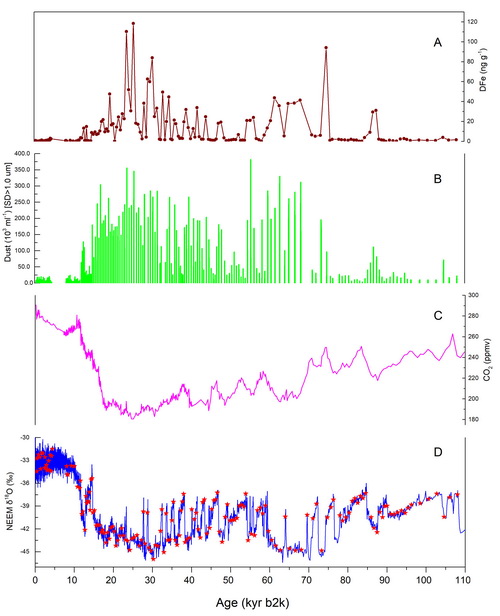Scientists Found Iron linkages between the Greenland Ice Core and Asian Loess Records
Updatetime:2020-07-15From:
【Enlarge】【Reduce】
Iron (Fe) records from Greenland ice sheet ice cores can provide a wealth of modern and paleoclimatic information on human activity, land and the ocean, and can be used to integrate the spatiotemporal distribution with transport dynamics of Asian dust.
However, still limited data on Greenland ice core are available for paleoclimate studies. Thus, accurate evaluations of the past and present atmospheric deposition of Fe in the Greenland ice core are needed.
Recently, as co-first author of this article, Dr. DU Zhiheng from the Northwest Institute of Eco-Environment and Resources of Chinese Academy of Sciences (CAS), together with Prof. XIAO Cunde (first author) from Beijing Normal University, firstly presented the results of measurements of the concentrations of dissolved Fe (DFe) and total Fe (TDFe) in the North Greenland Eemian Ice Drilling (NEEM) ice core over the past 110 kyr B.P.
Their study suggested that the DFe records in NEEM ice core were significantly anti-correlated with the carbon oxide (CO2) concentrations during the cold periods.
The results also emphasized that the changes of Fe fertilization effect could not be explained by a simple linear relationship with the glacial–interglacial changes in the CO2 concentration in the atmosphere.
This study also focused on the linkages between NEEM ice core and Chinese loess record over the past 110 kyr B.P. The changes of Fe fluxes in the NEEM ice core were in phase with that archived in Chinese loess, where the mineral dust distribution was controlled by the vast Asian deserts and large-scale wind pattern.
The dust input on a hemispheric scale were most likely driven by the changes in solar radiation during the last glacial-interglacial cycle, as a response to Earth’s orbital changes.
Although the burning of biomass has released large amounts of Fe-contained aerosols since the Industrial era, no significant responses observed in Fe variations during the same time period.
This study has been published in the National Science Review in an article entitled “Iron in the NEEM ice core relative to Asian Loess records over the last glacial-interglacial cycle”.

The δ18O (A), CO2 concentration (B), dust particle (C) and DFe (D) concentrations over the past 110 kyr B.P.. The red stars represent the ice samples for this study. The data of δ18O, dust particle and DFe from NEEM ice core, CO2 data from Antarctic EDC ice core. (Image by Dr. DU Zhiheng)
Contact:
DU Zhiheng
E-mail: zhihengdu@lzb.ac.cn
State Key Laboratory of Cryospheric Science, Northwest Institute of Eco-Environment and Resources, Chinese Academy of Sciences, Lanzhou 730000, China.
Appendix




